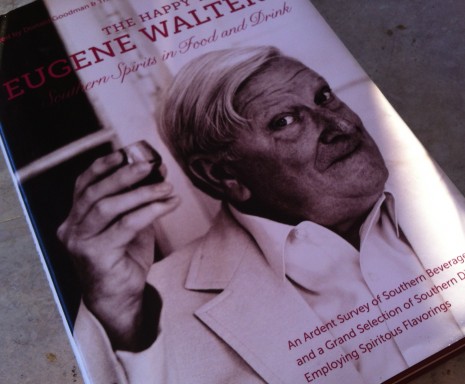THE HAPPY TABLE OF EUGENE WALTER
I greatly admire—scratch that. I’m in awe of those who can talk to a roomful of people about a single subject without benefit of notes. I could practice from now to kingdom come and never achieve their ease, let alone their ability to synthesize complex material on the fly, avoid tangential to-ing and fro-ing, form complete sentences, and be witty and engaging, to boot.
That is why I agonize over any presentation, most recently, for last week’s Roger Smith Cookbook Conference. The topic of our panel discussion was how one transforms the act of cooking into clear-as-a-bell printed instructions on the page. My partners in crime were the masterful Grace Young, who both demystifies and elevates the art of stir-fry cooking, and the equally masterful Tina Ujlakis, longtime executive food editor at Food & Wine. Interestingly, they both spent time at Time-Life; Tina worked on The Good Cook book series, and Grace, as the company’s test kitchen director, oversaw more than 40 cookbooks.
Their connection put me in mind of the extraordinary food writer Eugene Walter (1921–1998), a native of Mobile, Alabama, and bon vivant who wrote American Cooking: Southern Style, part of Time-Life’s beloved Foods of the World series. Mr. Walter was a raconteur of the highest order; to get the flavor of the man, check out the homage here, from the 2006 Southern Foodways Alliance symposium. It’s a star turn from a few gentlemen who are no slouches in the storytelling department themselves.
One of them was Don Goodman, Mr. Walter’s literary executor; along with food writer Tom Head, he assembled and edited the book that Mr. Walter had been working on at the end of his life, The Happy Table of Eugene Walter: Southern Spirits in Food and Drink, published in 2011 by the University of North Carolina Press. I’ve been meaning to write about it ever since, and I may as well seize the moment.
It’s wonderful, of course. There are chapters devoted to eggnog, punch, bourbon, “Juleps, Mint and Otherwise,” and everyone’s favorite, “The Cocktail, or I Feel Better Already.” The section called “Victuals” features dishes that call for alcohol, including many that were almost lost during Prohibition and the Depression. There are also charming illustrations by the author, and enlightening little essays on subjects such as “smears” for roasts. “Most Gulf Coast traditional households have coatings that are spread on meat roasts before cooking—marinades, but what in local talk is a ‘smear,'” Mr. Walter explains. “Roasts are ‘smeared,’ covered with a clean damp towel, and left for half an hour before being grilled or baked. Every household has its private formula for a smear, maybe several smears, differing according to the meat. Almost all smears have bourbon as a kind of coordinator. Most ham or pork smears are sweet.”
Personally, I have had very good luck with the smear for ham outlined below:
“One famous Mobile cook prepared ham in this fashion: Cut some fat from the ham and melt it in a frying pan. Smear ham all over with fat. The night before, or some hours before make the smear mix and keep it in the fridge. This consists of minced sweet onion, a bit of minced kumquat or orange peel, a good glop of unrefined honey or molasses, a dash of Tabasco, and freshly ground black pepper, all well mixed. A half cup of best bourbon was mixed in, and this smear was spread all over the roast before it went into the oven.”
You don’t so much read The Happy Table as sit at it, and not want the party to end. You’re in the hands of a capable cook, one who has a big appetite and considers being in the kitchen great fun. The last time I picked up the book, I enjoyed Mr. Walter’s sharp observations on the interpretative aspect of recipes and realized they’d be a good kicker to my presentation. The audience seemed to like Mr. Walter’s words, and I hope you will, too.
ON RECIPES & MEASUREMENTS
From The Happy Table of Eugene Walter, edited by Donald Goodman and Thomas Head (University of North Carolina Press, 2011)
“No one has ever questioned or expressed uncertainties to me about the use of ‘pinch,’ ‘dash,’ and so on as measurements. In the long run, I feel the ‘pinch’ is much more precise that the ‘1/8 of a teaspoon’ employed in more prissy-proper recipes. The great southern cooks, well aware of differences of altitude, climate, temperament, astrological signs, mood, degree of appetite, type of stove, kinds of kitchen equipment, and, most of all, the eaters for whom they cook, would never specify precisely such a measurement. They know what is meant by splash, dribble, dollop, lump, squirt, and hint, the difference between a dusting and a topping, between a dash and a pinch. Above all they know that recipes are to be interpreted and so read a recipe rather as Wanda Landowska might read a page of Scarlatti for the first time or as Van Cliburn might peruse a newly discovered Mussorgsky prelude. Above all, the serious cook knows who is coming to table, whether a ladies’ luncheon of reducers; a gang of greedy-guts teenage boys; the steak-and-potato set in need of introduction to, say, a grits-cheese-and-garlic soufflé; thin Aunt Mayhem in from gardening, ravenous and tucking in; or fat Uncle Picky, soaked in rum and taking only little forkfuls.
“The best advice to cooks is, I feel, seek fresh, avoid chemicals, keep a light hand, rise to the occasion, try what you don’t know, have fun … and good eating, you-all!”
Posted: February 13th, 2013 under cookbooks, favorite books, people + places, recipes.



Comment from Naomi McEneely
Time February 20, 2013 at 8:00 pm
Jane,
I loved that story at the conference and I still love it now.
I hope you are well and warm,
Naomi